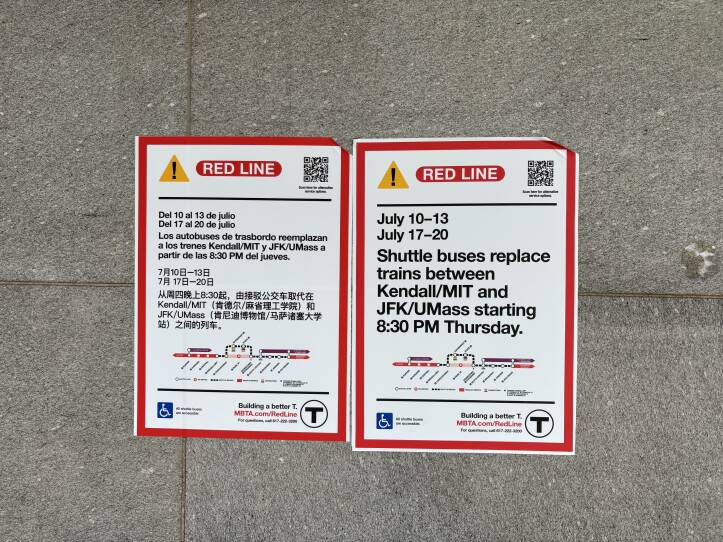The slow zones are gone. The shutdowns are shorter. But T riders are still frustrated by the deluge of recent service changes that have forced riders off of trains and onto shuttle buses.
For the second week in a row, the MBTA is closing down a key piece of the Red Line for three days. Starting Thursday at 8:30 p.m., trains won’t run through Downtown Boston until Monday morning, with shuttle buses replacing service between Kendall/MIT and JFK/UMass as crews conduct routine maintenance work and track repairs.
“This is really negatively impacting my commute,” said Michaela Boyd from South Boston. “And they do this really frequently.”
Boyd was among scores of Red Line riders forced to navigate confusing signage near Downtown Crossing Station during last week’s closure. After walking a couple blocks from the station’s entrance to the designated shuttle bus stop, she found herself standing alongside dozens of other commuters, crowded along the sidewalk in the summer heat as they waited for a shuttle to arrive.
She was late for work, and taking a shuttle bus instead of the subway – especially in downtown traffic – was set to make matters work.
“This has added about 45 minutes to my travel,” Boyd said. “My message to the T’s leaders is: 'Get it together!’”
Over the past two years, the MBTA has been working to get it together, taking dramatic measures to improve service. When General Manager Phil Eng stepped in as the T’s new leader in April 2023, he promised to lift dreaded slow zones on all subway lines by the end of 2024.

In order to do that, the agency instituted a series of staggered closures on portions of every line in order to replace more than 140,000 feet of rail and upgrade the system’s aging infrastructure. It was an ambitious and aggressive plan, but it worked. By January 1, 2025, the system was entirely free of speed restrictions for the first time in 20 years.
“This is an awesome milestone,” Gov. Maura Healey said at the time. “Riders are getting more time back in their days and our entire economy is seeing the benefits.”
But for riders, the story is more complicated. Even though the slow zones have been eliminated, the T is still regularly closing train lines in order to conduct maintenance work and upgrade the system’s signal system, which tells trains when to stop and go. Over the next month alone, there are five separate planned closures taking place on the Red Line, Orange Line and commuter rail.
Most of those shutdowns are scheduled for evenings or weekends to reduce the impact on riders, but for commuters like Voleme Jean Baptiste, who works weekends, the struggle is real.
“I take the Orange and Red Lines,” he said. “It’s very hard. I have to walk away from the Orange Line, then look for the shuttle buses. It takes another 10 to 15 minutes total.”
In addition to planned closures, the T has also struggled with high-profile incidents that have stranded passengers. On Tuesday, more than 450 riders were forced to evacuate from a Blue Line tunnel under Boston Harbor after an old cable came down and halted trains. Eng said the agency will fix the cable and apologized to riders.
“It’s understandable that riders are frustrated,” said Caitlin Allen-Connelly, executive director of the transportation advocacy nonprofit Transit Matters. “Whether it’s these planned shutdowns or a short-term disruption, it’s tough.”
Allen-Connelly said it makes sense that some passengers are feeling shutdown fatigue. But she believes there’s no alternative. Maintenance work, she argues, is essential for a system as old as the T, and planned closures will allow crews to upgrade that aging infrastructure to prevent incidents like the Blue Line evacuation in the future.
“The T is much like someone’s home or apartment,” she said. “It really demands continuous upkeep.”





